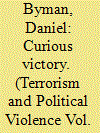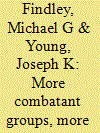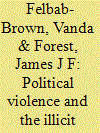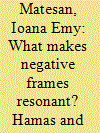|
|
|
Sort Order |
|
|
|
Items / Page
|
|
|
|
|
|
|
| Srl | Item |
| 1 |
ID:
116342


|
|
|
|
|
| Publication |
2012.
|
| Summary/Abstract |
This article undertakes a descriptive analysis of the jihadist group, the Global Islamic Media Front. Using information obtained from cells broken up in the West, it argues that, in addition to its propaganda actions in support of terrorism, the group fulfils three additional functions: (a) It serves as an "identity refuge" for individuals wishing to cultivate an identity as fighters of the jihad; (b) It offers a form of "surrogate activism" to those who fail in their attempts to join organisations engaged in terrorist violence; and (c) It is an important source of violent radicalisation for its own members who become increasingly dissatisfied with their propaganda activities.
|
|
|
|
|
|
|
|
|
|
|
|
|
|
|
|
| 2 |
ID:
116345


|
|
|
|
|
| Publication |
2012.
|
| Summary/Abstract |
The article examines Israel's successes and failures during the Second Intifada. It argues that Israel's advances came from an effective counterterrorism campaign involving a mix of military operations, defensive measures, and in particular improved intelligence gathering. Domestic resilience also proved strong in the face of a brutal terrorism campaign. Yet long-term victory remains elusive for Israel. Deterrence, always difficult against terrorist groups, is growing harder for Israel. Hamas's control of Gaza, and the mistrust and hatred sown during the Second Intifada, have hindered a political deal between Israel and moderate Palestinians. Much of what went into successful counterterrorism, notably the security barrier and the aggressive campaign of raids and arrests, does not jibe with most visions of what peace would look like and makes a deal harder to achieve. To make a peace deal work, Israeli counterterrorism must change, with measures including relocating parts of the security barrier, bolstering moderate Palestinian politicians, and working with, as opposed to undermining, Palestinian security forces in the West Bank.
|
|
|
|
|
|
|
|
|
|
|
|
|
|
|
|
| 3 |
ID:
116344


|
|
|
|
|
| Publication |
2012.
|
| Summary/Abstract |
In the following article, factors with an effect on the radical practice of religion in diaspora communities will be examined. Three factors play a major role in the religious radicalisation of the Islamic diaspora, often referred to as Islamism or religious activism: 1. The Islamist movement in the home country of the immigrants, 2. The situation created by immigration in which religion fulfils functions beyond purely spiritual needs and 3. A personal crisis resulting in individuals being receptive to extremist ideas. After a short conceptual explanation, the development of the Islamist movement in Turkey, which had a strong impact on the diaspora communities, will be traced. Following that, the role of religion for first- and second-generation immigrants will be discussed and individual crisis situations that aid extremism and violent radicalisation will be looked at. The conclusion drawn here allows statements to be made with regard to future tendencies towards violent radicalisation and their religious embedding.
|
|
|
|
|
|
|
|
|
|
|
|
|
|
|
|
| 4 |
ID:
116339


|
|
|
|
|
| Publication |
2012.
|
| Summary/Abstract |
We examine and test the logic that outbidding among insurgent groups results in more suicide terrorism specifically and more terrorism of any type, which has become a popular argument in recent years. A global analysis of terrorism from 1970-2004 provides scant support for the notion that outbidding increases suicide terrorism. An extension of the argument to all types of terrorist attacks provides even less support. The logic of outbidding has received considerable attention in academic and policy circles in recent years. 1
Similar to the argument that democratic occupation increases suicide terror, 2 our lack of empirical support suggests that considerable cross-national work is still needed to understand suicide terror adequately. We suggest some reasons why this may be the case, drawing particular attention to the problem of overgeneralizing from a limited set of cases.
|
|
|
|
|
|
|
|
|
|
|
|
|
|
|
|
| 5 |
ID:
116341


|
|
|
|
|
| Publication |
2012.
|
| Summary/Abstract |
How does the way in which a group organizes change the lethality of the group's attacks? In this article, we argue that groups organized vertically as hierarchies are likely to conduct more lethal attacks. We build our argument around three advantages inherent to centralized structures: functional differentiation, clear command and control structures, and accountability. We argue that each of these characteristics positively impacts an organization's ability to deliver an effective lethal blow. To test our argument, we use a mixed method approach, drawing on empirical evidence and support from a time-series case study. Our large-N analysis examines the trends in more than 19,000 attacks. In this test we develop a novel proxy measure for hierarchy based on a group's bases of operation and non-violent activities. To complement the empirical work, we examine the history of Euskadi Ta Askatasuna (ETA), the Basque separatist group. Over several decades of violent operations, this group's structure has changed dramatically. We analyze how these shifts impacted ETA's ability to maximize the effectiveness and damage of their attacks. In both the case study and large-N analysis, the more hierarchically organized the group, the more easily the group can orchestrate lethal attacks.
|
|
|
|
|
|
|
|
|
|
|
|
|
|
|
|
| 6 |
ID:
116343


|
|
|
|
|
| Publication |
2012.
|
| Summary/Abstract |
This comparative analysis draws on field research in several West African countries to illustrate the dynamic relationships between political violence and organized crime in this sub-region. These relationships are often transactional, and almost always on a temporary basis. While some alliances of convenience may be forged, in other cases an adversarial relationship exists between organized crime and terrorist networks. In some cases, key actors within West African governments have benefited from these relationships. We then examine recent policies and strategies pursued by the U.S. and the international community that, in the name of combating terrorism, seek to constrain the illicit economies of the region, but in doing so may do more harm than good. The article concludes with some policy recommendations based on this analysis.
|
|
|
|
|
|
|
|
|
|
|
|
|
|
|
|
| 7 |
ID:
116340


|
|
|
|
|
| Publication |
2012.
|
| Summary/Abstract |
Institutional and economic development has recently returned to the forefront of economic analysis. The use of case studies (both historical and contemporary) has been important in this revival. Likewise, it has been argued recently by economic methodologists that historical context provides a kind of "laboratory" for the researcher interested in real world economic phenomena. Counterterrorism economics, in contrast with much of the rest of the literature on terrorism, has all too rarely drawn upon detailed contextual case studies. This article seeks to help remedy this problem. Archival evidence, including previously unpublished material on the DeLorean case, is an important feature of this article. The article examines how an inter-related strategy, which traded-off economic, security, and political considerations, operated during the Troubles. Economic repercussions of this strategy are discussed. An economic analysis of technical and organizational change within paramilitarism is also presented. A number of institutional lessons are discussed including: the optimal balance between carrot versus stick, centralization relative to decentralization, the economics of intelligence operations, and tit-for-tat violence. While existing economic models are arguably correct in identifying benefits from politico-economic decentralization, they downplay the element highlighted by institutional analysis.
|
|
|
|
|
|
|
|
|
|
|
|
|
|
|
|
| 8 |
ID:
116338


|
|
|
|
|
| Publication |
2012.
|
| Summary/Abstract |
Increasingly, scholars are applying Social Movement Theory to explore how radical Islamist groups strategically employ framing to legitimize the use of violence. What has not been explicitly examined, however, is under what conditions radical frames are more resonant with the public than more moderate alternatives. This article argues that the strength of a particular frame depends on the credibility of the competing claim-makers. Drawing on public opinion polls from the Palestinian Territories, the article shows that the resonance of Hamas' frames vis-à-vis the peace process between 1993 and 2006 depended on the ability of the Palestinian leadership to maintain its legitimacy. Since the Gaza take-over and Hamas' shift to a position of leadership rather than opposition party, the organization's inability to deliver in the economic realm or to even feign any progress regarding the peace process damaged its credibility and reputation. Accordingly, its frames vis-à-vis the peace process also started losing their resonance with the public. An understanding of the dynamics of credibility can also help explain the continued moves towards national reconciliation between Hamas and Fatah.
|
|
|
|
|
|
|
|
|
|
|
|
|
|
|
|
|
|
|
|
|